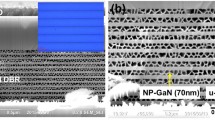Abstract
According to the theory of DBR, with the P-type DBR as an example, the electrical characteristics and optical reflection of the DBR are analyzed by studying the energy band structure with various graded region widths and doping densities. The width and doping density of graded region are decided through a comparative study. The P-type DBR of 980 nm VCSELs is designed with Al0.9Ga0.1As and Al0.1Ga0.9As selected as the high and low refractive index material for the DBR. The 980 nm bottom VCSELs, which consists of 30 pairs P-type DBR and 28 pairs N-type DBR, are then fabricated. In P-type DBR, the width of graded region is 0.02 μm and the uniformity doping concentration is 2.5×1018cm−3. Its reflectivity is 99.9%. In N-type DBR, the width of graded region is also 0.02 μm and the uniformity doping concentration is 2×1018cm−3. Its reflectivity is 99.3%. The I–V curve shows that the series resistance of the device is about 0.05 Ω. According to the theory of DBR, with the P-type DBR as an example, the electrical characteristics and optical reflection of the DBR are analyzed by studying the energy band structure with various graded region widths and doping densities. The width and doping density of graded region are decided through a comparative study. The P-type DBR of 980 nm VCSELs is designed, with Al0.9Ga0.1As and Al0.1Ga0.9As selected as the high and low refractive index material for the DBR. The 980 nm bottom VCSELs, which consist of 30 pairs P-type DBR and 28 pairs N-type DBR, are then fabricated. In P-type DBR, the width of graded region is 0.02 μm and the uniformity doping concentration is 2.5×1018cm−3. Its reflectivity is 99.9%. In N-type DBR, the width of graded region is also 0.02 μm and the uniformity doping concentration is 2×1018cm−3. Its reflectivity is 99.3%. The I–V curve shows that the series resistance of the device is about 0.05 Ω.
Similar content being viewed by others
References
Lai F I, Hsueh T H, Chang Y H, et al. 10 Gb/s single-mode vertical-cavity surface-emitting laser with large aperture and oxygen implantation. Semicond Sci Tech, 2004, (19): L86–L89
Zhao L M, Wang Q, Yan C L, et al. 980 nm high power vertical cavity surface emitting laser (in Chinese). Chin J Lasers, 2004, 31(2): 142–144
Hunziker S, Eitel S, Gulden K, et al. VCSEL arrays. Spie, 2001, 4286: 119–126
Ma Y, Wang C, Miao T Q. Blue light laser by direct frequency doubling of VCSEL (in Chinese). Opt Precis Engin, 2005, 13: 253–259
Sun Y F, Jin Z H, Ning Y Q, et al. Fabrication and experimental characterization of high power bottom-emitting VCSELs (in Chinese). Opt Precis Engin, 2004, 12(5): 449–453
Sale T E. Cavity and reflector design for vertical cavity surface emitting lasers. IEE Proc-Optoelectron, 1995, 142(1): 37–43
Iga K. Surface-emitting laser—its birth and generation of new optoelectronics field. IEEE J Select Topics Quantum Electron, 2000, 6(6): 1201–1214
Winston D W, Hayes R E. Optoelectronic device simulation of bragg reflectors and their influence on surface-emitting laser characteristics. IEEE J Quantum Electron, 1998, 34(4): 707–715
Piprek J, Tröger T, Schröter B, et al. Thermal conductivity reduction in GaAs-AlAs distributed bragg reflectors. IEEE Photon Tech Lett, 1998, 10(1): 81–83
Liu Y, Ng W C, Choquette KD, et al. Numerical investigation of self-heating effects of oxide-confined vertical-cavity surface-emitting lasers. IEEE J Quantum Electron, 2005, 14(1): 15–25
Author information
Authors and Affiliations
Corresponding author
Additional information
Supported partially by the National Natural Science Foundation of China (Grant Nos. 60636020, 60676034, 60577003, 60706007)
Rights and permissions
About this article
Cite this article
Li, T., Ning, Y., Hao, E. et al. Design and optimization of DBR in 980 nm bottom-emitting VCSEL. Sci. China Ser. F-Inf. Sci. 52, 1266–1271 (2009). https://doi.org/10.1007/s11432-009-0073-1
Received:
Accepted:
Published:
Issue Date:
DOI: https://doi.org/10.1007/s11432-009-0073-1




